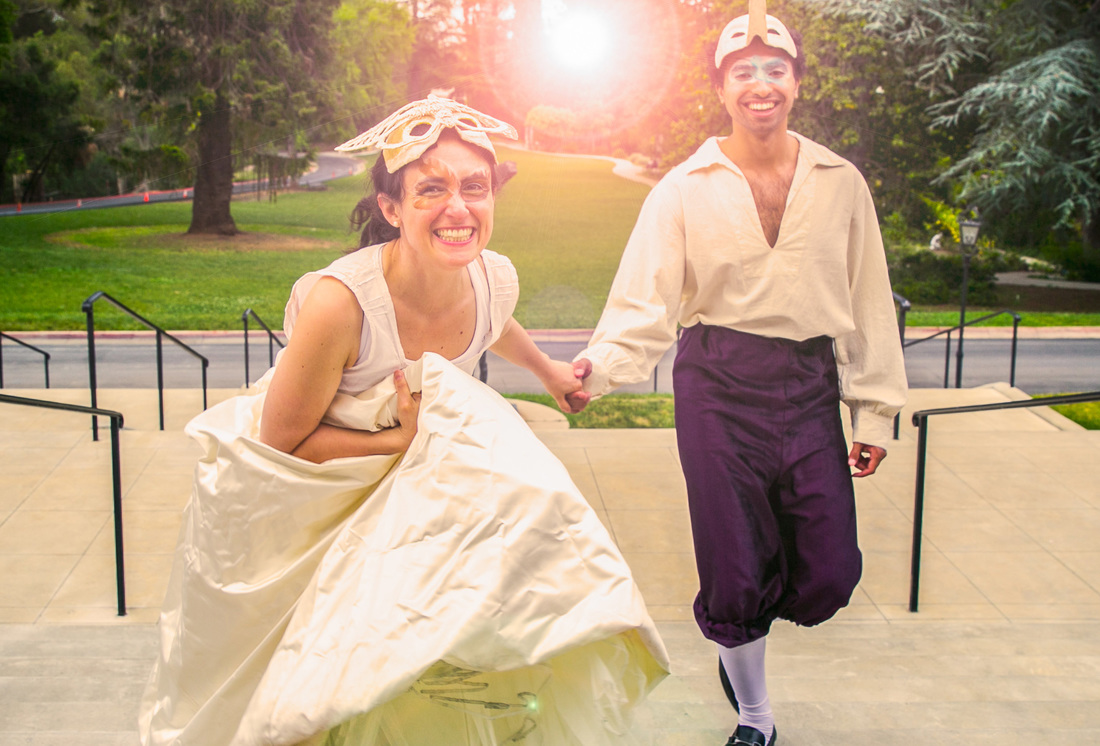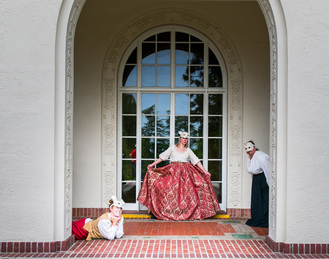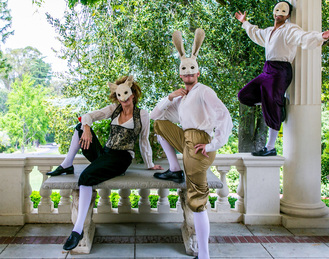This spring, as we celebrate the 400th anniversary of Shakespeare’s death (and We Players’ own Sweet Sixteen), the We Players cast and crew worked together to develop the underpinnings of their unique approach to Romeo and Juliet . They were joined at the LAP by Monica Lundy, a visual artist and past Fellow. Lundy spent the summer of 2015 in residence at the LAP alongside Roy, and after a month of artist dinners on the picnic tables under the oak trees — where warm nights sometimes stretched conversations late into the evening and poetry was served for dessert —
they had planted the seeds for a future artistic collaboration. Roy invited Lundy to return to the LAP with the We Players team, to collaborate with them on their new theater production. An artist who creates striking mixed media paintings, Lundy stepped out of her comfort zone and agreed to develop a series of animal-themed masks for a key scene of Romeo and Juliet — the ball at the Capulet residence that initiates the drama of Shakespeare’s classic tragedy of love, risk, and miscommunication.
As the We Players developed these experiences at Montalvo, the villa and its gardens rang with new sounds: the clash of swords on the front lawn, the calls of the characters’ spirit-animals, the music of a rueda on the villa’s front terrace, and the loudest artist dinner ever held in the Lucas Artists Program Commons. One Thursday night, the full cast of Romeo and Juliet came to dinner in character, each armed with secret instructions designed by director Ava Roy to build insight into their character—instructions that also served to create maximum drama, hubbub and happy consternation. A night of hilarity and chaos ensued, the windows shook, and culinary artist Andrea Blum and lone novelist Lynn Freed leapt for cover as the We Players brought their characters to life at full throttle.
|
Above: Masks designed by Monica Lundy. Photo by Tina Case.
|
It is around the table at LAP that the soul of things is often created. At the first artist dinner—one of the quiet dinners before the full cast arrived—We Players’ Ava Roy, Britt Lauer and Moira McGovern and artist Monica Lundy leaned together over the question of animals. What would the masks be? Lundy sketched a sphinx moth on the tabletop with her finger, and Juliet came into being. Ava said “coyote,” and it was coyote. Lundy conjured the spirit of the female mountain lion that has been sighted with her cub near Montalvo—tagged and dubbed the largest mountain lion in the Santa Cruz mountains. Dessert was served, and “Capulet” came into being—mother mountain lion, a one-character amalgam of Juliet’s domineering parents who truss their daughter up in duty and send her to her death.
|
And Monica Lundy went to work in the clear light of studio 41. She hand-formed the mask of hummingbird as Romeo walked in Montalvo’s rose garden, learning how that bird loves. She gilded the frizzled brow of the sphinx moth carefully as Juliet explored what it means to love a flame. And the animals came to rest in the characters’ natures, and the characters came and inhabited the animals, and the play was born.
We Players will perform Romeo and Juliet in two locations, at Petaluma Adobe State Historic Park in August and September, then at Montalvo from October 6-16, 2016. Visit www.weplayers.org for details.
The Characters, their Animals, and their Humans
Nurse (quail): Jennie Brick
Juliet (sphinx moth, also known as hummingbird moth): Maria Leigh
Peter (mouse): Amy Nowak
Lady Capulet (mountain lion): Libby Oberlin
Benvolio (jackrabbit): John Steele Jr.
Friar Laurence: Rush Rehm
Romeo (hummingbird): Mohammad Shehata
Tybalt (bobcat) & Paris (heron): Steve Thomas
The Prince & Mercutio (coyote): Courtney Walsh ARTICLE BY LORI WOOD





